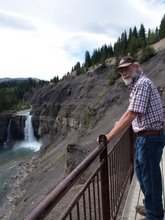The INF1 Innisfail solar farm has achieved approximately 19.57% of its theoretical maximum possible production during its lifetime operation from July 2020 through December 2025.[1][2][3]
Performance Overview
Since beginning commercial operations in July 2020, the 22 MW (AC) solar facility has been operating for 5.43 years, accumulating 1,984 days of generation. Based on design specifications, the farm was expected to produce 38,087 MWh in its first year, with a 0.4% annual degradation rate.[4][5][1][2]
Comparison of INF1 Innisfail Solar Farm's expected lifetime production versus theoretical maximum capacity over 5.43 years of operation.
Over this operational period, INF1's expected lifetime production totals approximately 205,041 MWh, compared to a theoretical maximum of 1,047,552 MWh if the facility operated at full 22 MW capacity continuously, 24 hours per day. This 19.57% figure represents the facility's capacity factor—the ratio of actual energy production to theoretical maximum output.[1][2]
Capacity Factor Analysis
The INF1 facility demonstrates a capacity factor of 19.76% based on its AC capacity rating. This performance metric is particularly noteworthy when compared to broader benchmarks:[1][3]
INF1 Innisfail solar farm's capacity factor of 19.76% significantly exceeds both Alberta and Canadian averages.
INF1's 19.76% capacity factor significantly exceeds the Alberta solar average of approximately 15%, representing a 31.8% performance advantage over typical provincial installations. This superior performance reflects optimal site selection near Innisfail, advanced bifacial solar panel technology, and efficient system design by GP Joule and Elemental Energy.[5][6][7][8]
The facility performs even more impressively against Canada's national solar average capacity factor of just 6%, which is heavily influenced by the country's high latitude and frequently cloudy conditions.[9]
Why Solar Capacity Factors Are Low
Solar photovoltaic systems inherently operate at relatively low capacity factors due to several fundamental constraints:
Diurnal Cycle: Solar panels generate no electricity during nighttime hours, immediately reducing potential production by approximately 50%.[7][10]
Seasonal Variation: Alberta experiences significant seasonal changes, with winter months featuring short days, low sun angles, and reduced solar irradiation. Solar capacity factors in Alberta range from lows of 5-10% in winter months to peaks of 25-30% during summer.[10][7]
Weather Dependencies: Cloud cover, precipitation, and snow accumulation on panels reduce generation capacity. Alberta's variable weather patterns contribute to production variability throughout the year.[7]
System Losses: Real-world efficiency losses occur through inverter conversion (DC to AC), electrical resistance in wiring, soiling on panels, and temperature effects on panel performance.[11][10]
Project Specifications
The Innisfail Solar Farm occupies 115 acres of town-owned land and features approximately 69,000 bifacial solar modules. The facility has a DC capacity rating of 25.3 MW and an AC capacity of 22 MW, with the difference reflecting inverter limitations. Construction employed approximately 75 workers at peak, with 80% from the local Innisfail and Red Deer County area.[4][5][2][3][8]
As Alberta's first merchant solar project, INF1 sells its electricity directly into the competitive Alberta wholesale market rather than through power purchase agreements. The facility generates approximately $190,000 in annual revenue for the Town of Innisfail through land lease payments, property taxes, and community development contributions.[5][3][8]
Context for Central Alberta
The INF1 facility's strong performance validates the Red Deer region as a viable location for solar development. Located in central Alberta near the Red Deer River watershed, the site benefits from relatively favorable solar irradiation levels while maintaining proximity to transmission infrastructure. The project's success has demonstrated that merchant solar facilities can operate profitably in Alberta's deregulated electricity market, even at northern latitudes where capacity factors remain below those of solar-rich regions in the southwestern United States.[4][5][7][8]
⁂
- https://alberta.csaregistries.ca/ghgr_listing/AEOR_ListingDetail.aspx?ProjectId=296
- https://www.dispatcho.app/live/INF1
- https://innisfail.ca/wp-content/uploads/2020/09/Innisfail_Solar_Farm_-_info_sheet.pdf
- https://majorprojects.alberta.ca/details/Innisfail-Solar-Project/4279
- https://innisfail.ca/energy-initiatives/
- https://businessrenewables.ca/resource/math-renewable-energy
- https://www.policyschool.ca/wp-content/uploads/2021/11/EFL49A_AB-Electricity_Neff-et-al.pdf
- https://electricalindustry.ca/changing-scenes/7002-gp-joule-to-build-alberta-s-first-merchant-solar-project/
- https://list.solar/plants/largest-plants/canada/
- https://www.aeso.ca/assets/Uploads/AWS-TruePower-AESO-Wind-and-Solar-Assessment.pdf
- https://www.solarnplus.com/how-to-calculate-solar-power-plant-capacity-factor/
- https://www.gem.wiki/Innisfail_Solar
- https://renewableenergyworldproject.wordpress.com/2025/03/23/how-to-calculate-solar-power-plant-capacity-factor-a-deep-dive-into-solar-performance/
- https://www.power-technology.com/data-insights/power-plant-profile-innisfail-solar-pv-park-canada/
- https://www.lifebynumbers.ca/the-solar-solution/solar-capacity-and-capacity-factor/
- https://elementalenergy.ca/project/innisfail-solar/
- https://www.deassociation.ca/newsfeed/innisfail-solar
- https://innisfail.ca/wp-content/uploads/2024/01/Innisfail-2023-SW-Solar-Farm_one-pager.pdf
- https://solaralberta.ca/wp-content/uploads/2021/02/SolarAB-Feb-2021.pdf
- http://www.rec-cer.gc.ca/en/data-analysis/energy-commodities/electricity/report/archive/solar-power-economics/economics-solar-power-in-canada-results.html
- https://www.thealbertan.com/innisfail-news/innisfails-solar-farm-project-put-on-hold-10147987
- https://mccac.ca/success-stories/innisfail-town-office-solar-pv/
- https://docs.nrel.gov/docs/fy13osti/57582.pdf
- https://solaralberta.ca/case-study/solar-farm-innisfail/
- https://www.stalbertgazette.com/local-news/how-innisfail-went-solar-mackenzie-elemental-barclay-3443731
- https://elc.ab.ca/wp-content/uploads/2025/02/Here-Comes-the-Sun-Solar-Law-in-Alberta-August-2021.pdf
- https://www.nrel.gov/pv/lifetime
- https://www.albertamsa.ca/assets/Documents/Q1-2021-Quarterly-Report.pdf
- https://www.aeso.ca/assets/Uploads/market-and-system-reporting/Annual-Market-Stats-2024.pdf
- https://iea-pvps.org/wp-content/uploads/2020/12/IEA-PVPS-LCI-report-2020.pdf
- https://www.facebook.com/groups/436248180001/posts/10169368000425002/
- https://www.ai4europe.eu/research/ai-catalog/solar-production-forecast-dataset
- http://ets.aeso.ca/ets_web/ip/Market/Reports/CSDReportServlet
- https://www.aeso.ca/download/listedfiles/2020-Annual-Market-Stats-FINAL.pdf
- https://www.pv-tech.org/from-energy-yield-real-time-performance-new-metric-pv-project-success/
- https://www.vhive.ai/why-your-solar-farms-performance-data-might-be-lying-to-you/
- https://www.facebook.com/groups/solaralberta/posts/1891004401306730/
- https://www.aeso.ca/market/market-and-system-reporting/data-requests/
- https://www.aeso.ca/market/market-and-system-reporting/
- http://ets.aeso.ca
- https://www.ieso.ca/power-data/data-directory
- https://www.aeso.ca/market/market-and-system-reporting/data-requests/historical-generation-data/
- https://www.aeso.ca/market/market-and-system-reporting/data-requests/current-supply-demand-asset-list/
- https://www.aeso.ca/market/market-and-system-reporting/data-requests/hourly-generation-metered-volumes-and-pool-price-and-ail-data-2001-to-july-2025/
- https://regulatorylawchambers.ca/wp-content/uploads/2023/02/Energy-Regulatory-Report-April-2021-Issue.pdf
- https://www.dispatcho.app/assets
- https://www.albertamsa.ca/assets/Documents/Wholesale-Market-Report-Q1-2025.pdf
- https://www.dispatcho.app/assets/solar
- https://www.aeso.ca/market/market-and-system-reporting/micro-and-small-distributed-generation-reporting/
- https://www.dispatcho.app/live/BSC1
- https://en.wikipedia.org/wiki/List_of_generating_stations_in_Alberta
- https://www.dispatcho.app
- https://www.energyhub.org/alberta/
- https://www.rmoutlook.com/beyond-local/central-alberta-towns-solar-farm-project-delayed-until-2025-9233956
- https://www.thealbertan.com/innisfail-news/innisfail-council-frustrated-with-renewable-energy-moratorium-7416598
- https://reddeeradvocate.com/2023/01/03/town-of-innisfail-looking-into-creating-its-own-solar-farm/
- https://www.tcenergy.com/siteassets/pdfs/power/alberta-power-marketing/power-market-updates/2023/tce-alberta-power-market-update-july-2023.pdf
- https://www.westernwheel.ca/beyond-local/innisfail-mayor-has-positive-solar-farm-chat-with-province-7820529
- https://www.reddit.com/r/alberta/comments/1odt45o/danielle_smiths_energy_policies_trigger/
- https://www.thealbertan.com/innisfail-news/innisfails-new-solar-farm-delayed-until-2025-9202888
- https://prd-api-efiling20.auc.ab.ca/Anonymous/DownloadPublicDocumentAsync/834502
- https://pipelineonline.ca/20-of-42-solar-facilities-30-of-44-wind-facilities-in-alberta-produce-no-power-at-noon-on-friday/
- https://na.goldbecksolar.com/solar-farm-innisfail/
- https://www.facebook.com/groups/letstalkalbertaindependence/posts/1788430158421852/



